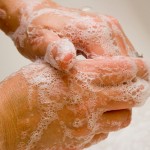Statistics show every 32 seconds a cold is caught in the United States. When including flu viruses, bacterial infections, and stomach illnesses, the statistics can make you want to hide at home. Take a deep, congestion-free breath, and arm yourself against the odds. Here are scientifically proven prevention methods …
Keep Exercising
It is a known fact that exercise helps keep you healthy. Regular exercisers report fewer colds and other viruses. According to a study conducted at the University of South Carolina, those most physically active on a daily basis were 20 to 30 percent less likely to develop colds than their inactive counterparts. The physical activity included exercise, sports performance, and physical chores such as snow shoveling. Working out also helps manage stress and anxiety, two culprits that lead to a weakened immune system.
Eat Breakfast
 Packed with numerous health benefits, the morning meal is also proven to boost resistance to cold germs. Through a study conducted at Cardiff University in Wales, cereal eaters were less likely to catch respiratory illnesses and colds than breakfast skippers. One possible explanation: Many breakfast foods are fortified with micronutrients, which have been linked to a reduced risk of infection.
Packed with numerous health benefits, the morning meal is also proven to boost resistance to cold germs. Through a study conducted at Cardiff University in Wales, cereal eaters were less likely to catch respiratory illnesses and colds than breakfast skippers. One possible explanation: Many breakfast foods are fortified with micronutrients, which have been linked to a reduced risk of infection.
For more on breakfast’s healthy effects, see “Rise, Eat & Shine” at https://fitnessandwellnessnews.com/nutrition/rise-eat-shine.
Get a Flu Shot
One flu shot does it this year. The immunization combines protection against the H1N1virus (swine flu) and the two other influenza viruses expected to circulate this season. The Centers for Disease Control and Prevention (CDC) recommend everyone six months of age and older be vaccinated.
Flu shot facts:
- Vaccinate between September and mid-November before flu season typically hits. The vaccine usually is strongest for the first six months.
- Get immunized every year to combat new strains of the virus.
- The flu vaccine cannot give you the flu. For a day or two, it can give you flu-like symptoms as a side-effect to your body producing protective antibodies.
- Approximately two weeks are required for the vaccine to take full effect. Unfortunately, you can contract the flu prior to getting the shot and have it hit you afterward.
- According to the CDC, flu vaccines are 70 to 90 percent effective in warding off flu in healthy people under age 65, when the immunization is a good match to that year’s circulating flu virus.
- As per the CDC inactivated influenza fact sheet: Children younger than nine years of age, who are getting a flu vaccine for the first time—or who got the flu vaccine for the first time last season but only got one dose– should get two doses spaced at least four weeks apart. Children don’t develop an adequate antibody level the first time they get the vaccine.
- Do not get a flu shot if you are allergic to chicken eggs or any other component of the vaccine, have a fever that day, or experienced a bad reaction to the vaccine in the past. There may be other instances, in addition to these CDC guidelines, when a flu shot is not recommended. Speak to your physician to determine your needs.
Influenza weakens the immune system. In addition to being out of commission and feeling lousy for the duration of the flu, your body’s immune response becomes weakened. You become more susceptible to other viruses, which often results in a season filled with colds.
If you suspect you’ve contracted the flu, contact your physician. Antiviral medication taken during the first 48 hours of symptom onset can reduce the duration and severity of the flu, and minimize complications from the virus.
 Wash Hands Frequently & Correctly
Wash Hands Frequently & Correctly
Germs often enter the body by touching your mouth, eyes, and nose. Minimize your exposure to germs by washing hands often throughout the day. It’s especially important to wash before and after treating a sick or wounded person. You also need to clean your hands prior to eating or preparing food. It’s essential to wash after using the bathroom or diapering.
Hand-washing is necessary, and not always considered, in these situations: when handling animals, garbage bags, public pens, phones, contact lenses, public toys, and blowing one’s nose. Head straight to the sink when arriving home to wash away outside germs.
Rest assured: The Childcare room at the Center is frequently disinfected throughout the day to minimize germ spreading. Hand-washing is encouraged, and should be practiced upon entering and leaving.
Anything worth doing is worth doing well. Here’s how to wash properly for best results:
- Wet hands with warm running water.
- Lather soap for at least 20 seconds. Scrub vigorously between fingers, under nails, on backs of hands, and on wrists.
- Rinse well.
- Dry with a clean towel. If possible, turn off the faucet with a disposable towel. Do not share a towel with other household members who are sick.
When soap and water are not available, antibacterial cleansers conveniently do the job. They are available in a variety of sizes, scents, and moisturizing formulas. Carry them in your car, purse, and on kids’ lunchboxes. Often, teachers require a small bottle be kept with students.
Get Your Sleep
Seven or eight hours of good sleep a night helps build your immune system. Sleep deprivation impairs your ability to fight off germs. Those who sleep 4 hours a night have weaker immune systems than those who get 7.5 to 8.5 hours, according to a University of Chicago study.
Sheldon Cohen, Ph.D. (social psychology; Laboratory for the Study of Stress, Immunity, and Disease) of Carnegie Mellon University, Pittsburgh, and colleagues conducted a study of 153 healthy men and women (average age 37). Their sleep was monitored for over a two-week period prior to being administered nasal drops containing the rhinovirus (cold-causing germ). Their conclusion: The less an individual slept, the more likely he/she was to contract a cold.
Consider an evening yoga class at the Center. Soothe away the day’s stresses with gentle stretching and meditative moments to still the mind and relax the body. You’ll leave refreshed and ready to prepare for a good night’s rest.
Gargle
Just plain water does the trick. A recent Japanese study determined those who gargled with water three times daily had 36 percent fewer colds than those who didn’t gargle at all. They also had fewer colds than those who used an antiseptic mouth rinse.
Gargling helps keep the throat moist, which increases the ability of throat cells to prevent viruses from entering the respiratory tract. It also flushes away mucus build-up (where germs can thrive) that results from draining sinuses.
Harvard researchers determined the immune systems of tea drinkers responded five times more efficiently to germs than those of coffee drinkers. Tea contains antioxidants as well as a potent class of chemicals called catechins. Both are believed effective in charging one’s immune system. Sipping tea also calms and comforts when suffering from a cold.
Exercising When Sick
Despite our best efforts, colds and viruses sometimes occur. The average adult suffers two to three respiratory infections every year, according to the American Council on Exercise. Many debate if exercise is smart during such times.
Fitness expert and author Chris Freytag offers this simple decision-maker: Permit a workout when symptoms remain above the neck, such as sore throat and sinus congestion. Often in these instances, physical activity will help improve congestion and combat fatigue. If symptoms exist below the neck– such as body aches, chills, and stomach issues– postpone your workout for another day. In all cases, when a fever is present, skip exercise. Always follow your instincts, and exercise at your own pace.
Reminder
Please wipe down exercise equipment with conveniently supplied disinfecting wipes before and after use. Include the area where you place your workout towel or other belongings. Hand sanitizer is also readily available for use throughout the Center.
Sources
“Flu Shot: Your Best Bet for Avoiding Influenza,” at mayoclinic.com.
“Preventing Colds, Flus, and Infections,” at drgreene.com.
“Should I Exercise While Sick?” by Chris Freytag at www.prevention.com.
“Wave Goodbye to Colds for Good!” by Hallie Levine Sklar at www.fitnessmagazine.com.
“What You Need to Know,” Inactivated Influenza Vaccine 2009-1010, fact sheet, Centers for Disease Control and Prevention.
Image Credits
Cereal & Fruit: www.flickr.com/photos/ralphandjenny/4436764804
Hand-washing: www.flickr.com/photos/arlingtonva/4314530838
Tea cup: www.flickr.com/photos/waferboard
 Fitness & Wellness News Your Source for Fitness News, Wellness News, Health News, and Nutrition News!
Fitness & Wellness News Your Source for Fitness News, Wellness News, Health News, and Nutrition News!




